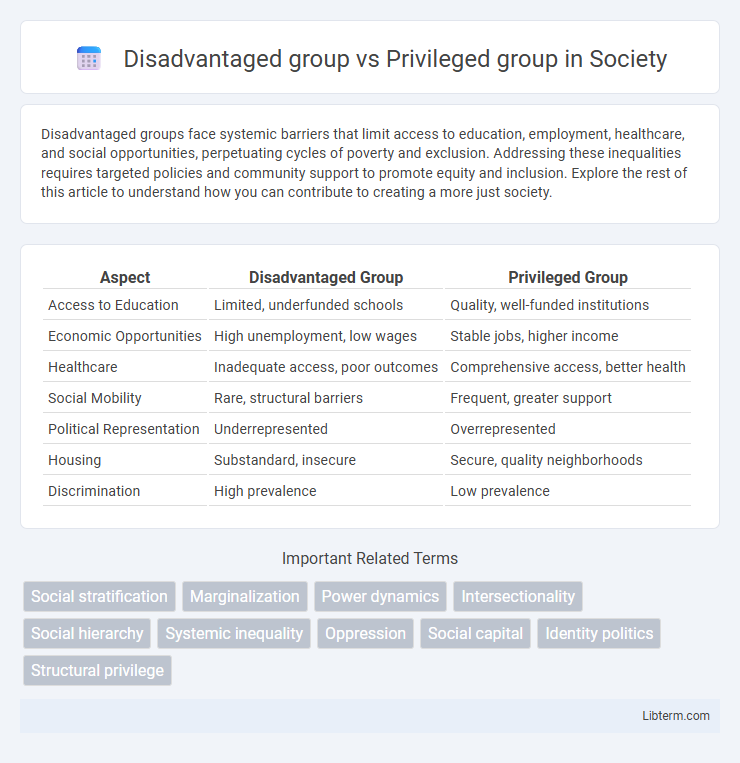Disadvantaged groups face systemic barriers that limit access to education, employment, healthcare, and social opportunities, perpetuating cycles of poverty and exclusion. Addressing these inequalities requires targeted policies and community support to promote equity and inclusion. Explore the rest of this article to understand how you can contribute to creating a more just society.
Table of Comparison
| Aspect | Disadvantaged Group | Privileged Group |
|---|---|---|
| Access to Education | Limited, underfunded schools | Quality, well-funded institutions |
| Economic Opportunities | High unemployment, low wages | Stable jobs, higher income |
| Healthcare | Inadequate access, poor outcomes | Comprehensive access, better health |
| Social Mobility | Rare, structural barriers | Frequent, greater support |
| Political Representation | Underrepresented | Overrepresented |
| Housing | Substandard, insecure | Secure, quality neighborhoods |
| Discrimination | High prevalence | Low prevalence |
Defining Disadvantaged and Privileged Groups
Disadvantaged groups face systemic barriers that limit access to resources, opportunities, and social mobility, often due to factors like race, socioeconomic status, gender, or disability. Privileged groups benefit from unearned advantages and greater access to power, wealth, and social influence, arising from historical and structural inequalities. Understanding these distinctions is crucial for addressing social justice and implementing equitable policies.
Historical Roots of Social Inequality
Historical roots of social inequality stem from systemic power imbalances established through colonization, slavery, and discriminatory laws that privileged dominant groups while marginalizing disadvantaged populations. Institutionalized practices such as segregation, unequal education access, and limited economic opportunities have perpetuated disparities between privileged and disadvantaged groups across generations. This legacy of exclusion and oppression continues to influence social, economic, and political inequalities in contemporary society.
Key Characteristics of Privileged Groups
Privileged groups possess systemic advantages such as greater access to quality education, higher-income opportunities, and influential social networks that reinforce their societal status. They often benefit from institutional support, including legal protections, cultural dominance, and representation across political and economic spheres. These advantages perpetuate inequality by limiting upward mobility for disadvantaged groups and sustaining privilege within dominant communities.
Structural Barriers Faced by Disadvantaged Groups
Disadvantaged groups encounter structural barriers such as limited access to quality education, employment discrimination, and inadequate healthcare services, which hinder their socio-economic mobility. These systemic obstacles are often embedded in institutional policies and societal norms, perpetuating inequality and limiting opportunities for advancement. Addressing structural barriers requires comprehensive reforms that promote equity and inclusion across education, labor markets, and healthcare systems.
The Role of Power and Access in Society
Power dynamics profoundly shape the experiences of disadvantaged and privileged groups, determining access to resources, opportunities, and social influence. Privileged groups often control economic, political, and cultural capital, reinforcing systemic inequalities that limit the mobility and rights of disadvantaged groups. Structural barriers such as discriminatory laws, unequal education systems, and biased social networks perpetuate disparities in wealth, health, and political representation between these societal groups.
Socioeconomic Impacts on Life Opportunities
Disadvantaged groups face significant socioeconomic barriers that limit access to quality education, healthcare, and employment opportunities, perpetuating cycles of poverty and social exclusion. Privileged groups benefit from greater financial resources, social networks, and institutional advantages that enhance life chances and foster upward mobility. These disparities underscore the critical role of socioeconomic status in shaping life outcomes and reinforcing structural inequalities.
Intersectionality: Overlapping Forms of Disadvantage
Disadvantaged groups often face overlapping forms of marginalization due to intersectionality, where race, gender, socioeconomic status, and disability intersect to compound social inequalities. Privileged groups typically benefit from systemic advantages rooted in these same identity markers, reinforcing disparities in access to resources, opportunities, and social power. Understanding intersectionality reveals how multiple forms of disadvantage overlap, creating complex layers of oppression that impact individuals differently within both disadvantaged and privileged communities.
Stereotypes, Representation, and Social Perceptions
Disadvantaged groups often face negative stereotypes that perpetuate social marginalization and limit opportunities, while privileged groups benefit from positive societal assumptions that reinforce their status. Representation of disadvantaged groups in media and leadership roles remains disproportionately low, contributing to skewed social perceptions and systemic inequalities. Social perceptions rooted in stereotypical narratives influence policy-making and public attitudes, further entrenching disparities between disadvantaged and privileged populations.
Policy Approaches to Address Inequality
Policy approaches to address inequality between disadvantaged and privileged groups prioritize targeted social programs, affirmative action, and equitable resource allocation to close gaps in education, employment, and healthcare. Governments implement anti-discrimination laws and invest in community development to empower disadvantaged populations and reduce systemic barriers. Data-driven strategies emphasize monitoring outcomes and ensuring accountability to promote social justice and economic inclusion.
Pathways to Social Justice and Inclusion
Disadvantaged groups often face systemic barriers in education, employment, and healthcare, limiting their pathways to social justice and inclusion. Privileged groups typically have greater access to resources, social capital, and institutional support, reinforcing existing inequalities. Effective strategies for social justice emphasize equitable policies, affirmative action, and inclusive practices that bridge these gaps and foster societal equity.
Disadvantaged group Infographic

 libterm.com
libterm.com